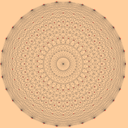
Arizona Winter School 2002
de Jong's Course and Project Descriptions
Rough outline of lectures
In the lectures we will discuss how a family of varieties gives rise to a variation of Hodge structures (Lecture 1). In Lecture 2 we discuss examples of variations of Hodge structure coming from certain explicit families of curves. In Lecture 3 we discuss a family of surfaces and its associated variation of Hodge structures. A common feature of the examples of Lectures 2 and 3 will be the existence of a Shimura variety parametrizing the geometric objects. In the final lecture we describe the variation of Hodge structure on H3 of a family of threefolds and we formulate a question which will hopefully be addressed by the students.
Prerequisites
Everybody should know what a Hodge structure is (this will not be explained in the lectures). There are several kinds; for us Z-Hodge structures and Q-Hodge structures will be the important ones. Students should know what a morphism of Hodge structures is, and how to take tensor products of Hodge structures, duals etc. It is also important to know what a polarization of a Hodge structure is.
Everybody should know what an algebraic variety is, and what a family of varieties is. (This will not be explained in the lectures.)
Useful to know: The cohomology on a nonsingular complex projective variety carries a natural polarizable Hodge structure. An abelian variety corresponds to a polarizable Z-Hodge structure of weight 1.
References
This is a little tricky since I do not know a short introduction to Hodge structures. You really don't have to know Hodge theory, you just have to know what a Hodge structure is. You can look at the original articles by Deligne, Griffiths for example. There is a book by Fouad El Zein ``Introduction à la théorie de Hodge mixte'' where you can find the definitions in Section 1.2. You can also look at Wells, R. O., Jr. Differential analysis on complex manifolds. Second edition. Graduate Texts in Mathematics, 65. Springer-Verlag, New York-Berlin, 1980. In general talking about Hodge structures with your friends might be a good preparation for this course.
Project description
We will take a particular variation of Hodge structures corresponding to a family of threefolds and we will try to determine whether the Hodge structures in question ever are reducible. This will be related to geometrical questions on the 3-folds and we will try to solve those instead. As an experiment, to guess the answers, we are going to do some counting of points on the 3-folds modulo p! (At least if there are any students who know how to use computers to count points in finite fields having p, p2,... elements.)
Additional, late-breaking details
Here is the counting of points that I would like to see (some of you, hopefully at least one) do:
For small primes p not equal to 5, say p=2,3,7,11,... and any s∈Fp ∪∞ count how many points the hypersurface
Zs : s(Y0+Y1+Y2+Y3+Y4)5 = Y0Y1Y2Y3Y4
in P4 has over Fp and and over Fp2. (You can also try to count over Fp3 and Fp4; we'll be able to use this information to check your results.)
For Fp points: I suggest to just try to use the ``stupid'' method where you simply make variable Ns for s=0,1,2,3,...,p-1 and s=∞. Then you just loop through all points (y0:y1:y2:y3:y4) of P4(Fp) and you increment Ns by one if your point lies on Zs. (Namely, if ∑ yi ≠ 0 then you just have to increment Ns where s is the quotient (∏ yi)/(∑ yi)5. If the sum is zero you have to be careful since there may be more than one Ns that has to be incremented.)
For Fp2-points: Again you can use the stupid method, but now you have to write a little program that allows you to compute in Fp2. It might be interesting to know the number of points on Zs also when s ∈ Fp2. (But in this case I would like to know the number of points for these Zs over Fp4 also.)
Please save the data as we are going to convert the numbers into characteristic polynomials of Frobenii.
I myself know absolutely ZERO about computers and algorithms. So it is quite possible that you're going to be able to find something smarter than what I propose above.